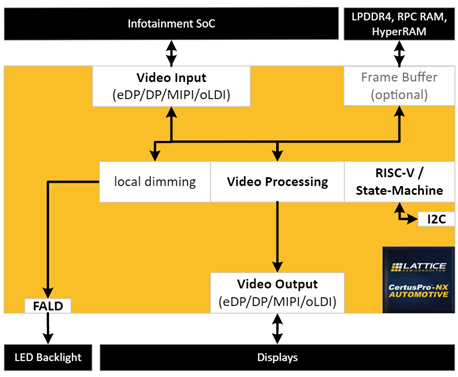The value of FPGA in the automotive industry
At present, the global automobile industry is entering the era of “new four modernizations” represented by intelligence, networking, electrification and sharing. According to IHS Markit data, by 2023, the total value of automotive electronic systems will reach as high as 180 billion US dollars, and each car will use more than 500 US dollars of semiconductor devices on average. system.
At present, the technology and architecture of the automotive industry are undergoing a process of rapid evolution. One of the important drivers behind this phenomenon is that OEMs are increasingly aware of the lack of correlation between ECUs from different manufacturers, and they must not Integrating an ECU without investing a lot of time and money into it makes integrating the ECU an “extremely hard job”.
However, the rapid development of connected cars and autonomous driving is changing this situation – in future designs, traditional distributed solutions will be replaced by integrated solutions, and hardware including ECUs and sensors will be highly integrated; automotive OEMs It will pay more attention to the innovation of customers at the interface software level and the ability to provide differentiated products for end customers.
In the field of smart cockpits, the new car-making forces represented by Tesla are highly integrating the dashboard, infotainment system and screen display, so that the content that needs to be displayed on a screen is becoming more and more abundant. The size is not uniform, which puts forward higher requirements for the partitioned display and diversified integration of images. However, this is not difficult for low-power FPGA products. Many car manufacturers are currently taking advantage of their programmable, strong parallel processing capabilities, low power consumption, and low heat dissipation to accelerate the introduction of relevant FPGA platforms.
At the same time, with the increasing trend of large-screen, multi-screen, high-definition and multi-form vehicle display. Many new cars have more than 2 screens, and some models even have 4-5 screens. With the increase in the number and size of in-car displays, people have put forward new requirements for display quality, hoping to obtain higher color gamut, higher contrast, and so on. Especially in order to alleviate mileage anxiety, how to improve the efficiency of large-size screens and make them more power-saving will be a common issue faced by the industry in the next few years.
In-vehicle vision systems and artificial intelligence technologies are now also widely used in driver status monitoring systems (DMS) and in-cabin monitoring systems (IMS), including: monitoring driver fatigue, distraction or injury; monitoring passengers to ensure No children/pets are inadvertently locked in the car or items such as bags, cell phones and wallets are not inadvertently left in the car.
Therefore, ISP image enhancement would be one of the most promising applications. For example, FPGAs can be customized for backlight optimization of LCD screens, which are currently used in large numbers in automobiles, to improve visual effects and save energy. At the same time, in order to support in-vehicle 4K display, FPGA also provides extensive support for high-speed data processing and interfaces, including 1.5G-2.5Gbps MIPI, HDMI, DisplayPort, etc.
In the application of advanced driver assistance systems, the latest data shows that an L3-level autonomous vehicle will be equipped with at least 16 sensors of various types. Since the main processor needs to connect different sensor interfaces for data processing, and the car interface is also Real standardization has not yet been achieved, so it is also one of the new trends to use the programmable features of FPGA to aggregate/bridge different sensors, or to achieve I/O interface expansion. At the same time, considering that the development of the automotive platform may take 5-10 years, the scalability of the solution also affects the user’s decision to select models.
Another area worthy of attention comes from electric vehicles, especially with the widespread use of wide-bandgap semiconductors such as silicon carbide, the accuracy of traditional DSP and even multi-core DSP control is becoming more and more difficult to meet the automotive industry’s requirements for timeliness and accuracy of drive control. boost, and FPGAs are being used heavily as an alternative.
Security is also of high concern. The emergence of more and more sensors, automatic control and network connections not only brings intelligent, convenient and comfortable experience to the car, but also makes the system more vulnerable to malicious attacks. OEMs must be able to instantly detect vulnerabilities and prevent cyber-attacks, as well as electronic systems that can operate stably and securely in harsh environments. It is even more critical for semiconductor devices to add hardware security engines that can protect, detect and recover firmware from unauthorized access.
CertusPro-NX automotive-grade FPGA series products are Lattice recently launched for applications such as high-speed video interconnection of in-vehicle infotainment (IVI) systems, 5GbE in-vehicle network (IVN) and ADAS sensor data processing. New FPGA with high performance and the smallest size in its class.
But this isn’t Lattice’s first foray into the automotive space. In fact, for general needs such as automotive lighting, infotainment systems and telematics, high-speed video and sensors, platform management and security applications in automotive design, Lattice has successively laid out the ECP/Certus series, CrossLink series and The MachXO series of modular hardware platforms, together with Radiant, DIAMOND, Propel design environments, and mVision, Automate and sensAI solutions, build a complete “modular hardware platform + reference design + neural network IP core + custom design service” ” matrix to accelerate and simplify the design process and time-to-market of automotive-related systems
As the fourth product series of the Nexus family, CertusPro-NX is mainly launched to meet the needs of innovative applications such as data co-processing in intelligent systems, high-bandwidth signal bridging in 5G communication infrastructure, and sensor interface bridging in ADAS systems. , and has been further improved in power design, system bandwidth, edge processing, reliability, packaging diversity and other aspects.
The reason for choosing such a design idea is that from the current industry development trend, the intelligence of network edge devices is greatly improving. On the one hand, they require higher interface bandwidth to facilitate rapid data transmission, and on the other hand More small form factor system integration and low-power solutions for optimized thermal management.
Compared with competing products, CertusPro-NX automotive grade devices not only have industry-leading energy efficiency and reliability, but also provide the industry’s best system bandwidth in an ultra-small package size, and are the only products in their class that support LPDDR4 external memory for FPGA products. CertusPro-NX automotive grade devices support up to 8.1Gbps SERDES, up to 96k logic cells, and have the most on-chip memory resources in their class for efficient processing.
With support for high-speed SERDES, CertusPro-NX automotive-grade products also add a number of unique features, support for video inputs to bridge infotainment SoCs, and image quality enhancements including local dimming, FPGA direct video processing, and embedded display support port. This family of devices offloads the video enhancements of the system while adding more connectivity (as shown in the figure below).

By leveraging Lattice’s innovations in FPGA architecture and 28nm low-power FD-SOI manufacturing process, CertusPro-NX devices consume four times less power than competing FPGAs. By changing the bias voltage of the substrate, developers can freely choose to operate in high-performance (HP) or low-power (LP) mode.
CertusPro-NX FPGA supports up to 8 programmable SERDES channels at speeds up to 8.1Gbps, provides the highest system bandwidth in its class (more than twice that of competing FPGAs), and supports mainstream communication and display interfaces such as 10Gigabit Ethernet, PCI Express, SLVS-EC, CoaXPress and DisplayPort.
The design area of CertusPro-NX FPGA is only 81mm2, which is 6.5 times smaller than that of competing devices. For example, the size area of Xilinx Artix-7 100K LC with the same logic unit is 529mm2, which is 6.5 times that of CertusPro-NX; and the size area is 121mm2 The Intel Cyclone V GT 77K LC has only 77K logic cells. Such a small form factor is a key design consideration for developers using SFP modules in automotive, industrial cameras or communication systems.
In addition, considering that critical applications in automotive, industrial and communications must have high reliability, enable predictable performance and ensure user safety, Lattice has improved the soft error immunity of CertusPro-NX devices by a factor of 100 and can Operates normally over a junction temperature range of -40°C to 125°C. Meanwhile, in order to protect its bit stream from unauthorized access, CertusPro-NXFPGA also supports AES-256 encryption and Elliptic Curve Digital Signature Algorithm (ECDSA) bit stream authentication. This means that CertusPro-NX FPGAs can bring extreme reliability to next-generation communications, embedded, industrial and automotive applications at a reasonable commercial cost, helping systems stay online at all times and keeping end users safe.
The above features and benefits of CertusPro-NX FPGAs are now AEC-Q100 qualified for use by automotive manufacturers. The first device CPNX-100K has 96K logic units, EBR (embedded memory) and large RAM reach 3.7Mb and 3.6Mb respectively, 18×18 DSP and PLL up to 156 and 4, and support 10GE PCS, PCIeGen 3, SGMII CDR, ADC and other hard core modules are expected to be mass-produced in Q1 2023.
Haoxinshengic is a pprofessional FPGA and IC chip supplier in China. We have more than 15 years in this field。 If you need chips or other electronic components and other products, please contact us in time. We have an ultra-high cost performance spot chip supply and look forward to cooperating with you.

